Anderson House
Introduction
Text-to-speech Audio
Images
The Anderson House is located along Embassy Row, a historic upscale neighborhood where politically important people of the United States and foreign countries mingle and conduct business. Wikimedia Commons.
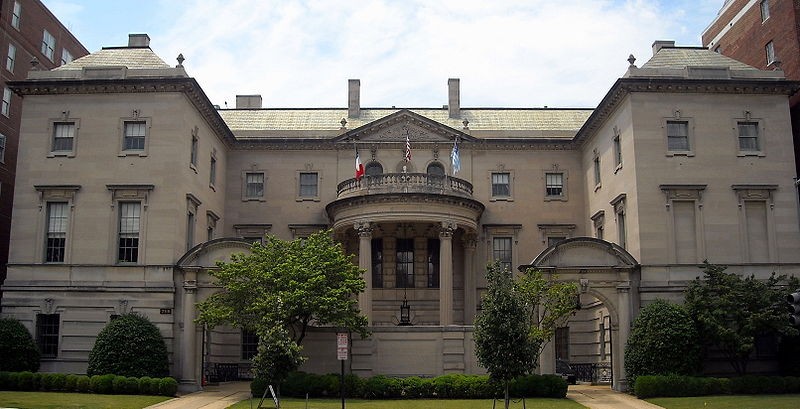
The lavish ballroom of the Anderson house, which includes ornate iron balconies and a staircase, tapestries, and decorative furniture. Courtesy of the Library of Congress.
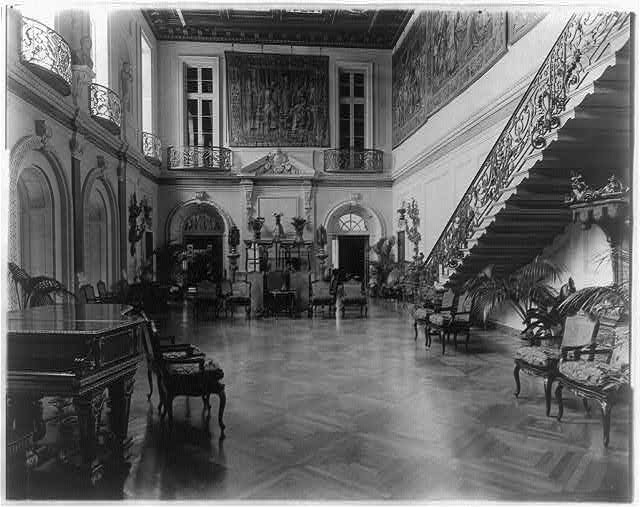
Larz Anderson was born into a wealthy family and spent his youth studying and traveling the world. Throughout his career, he was a diplomat to Britain, Italy, Belgium, and Japan. Courtesy of the Library of Congress.
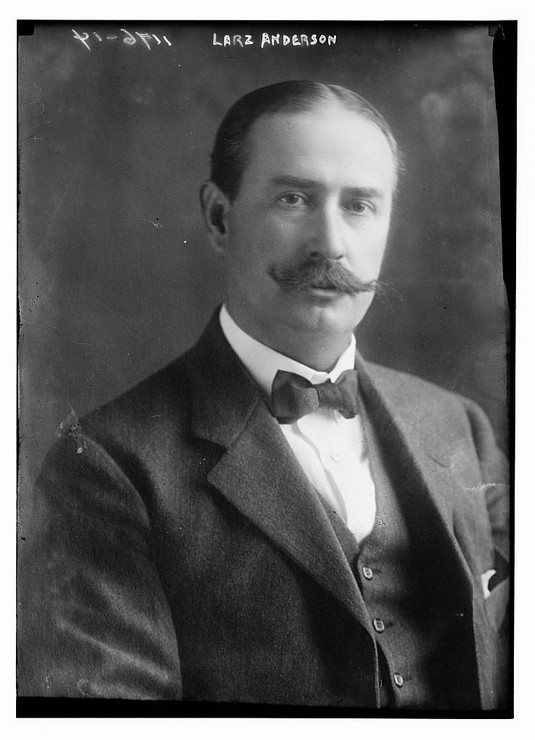
Isabel Weld Perkins Anderson descended from early American wealth and met Larz while enjoying her own European travels. She was an accomplished author of family histories, travel fiction, children's literature, and poetry. Library of Congress.
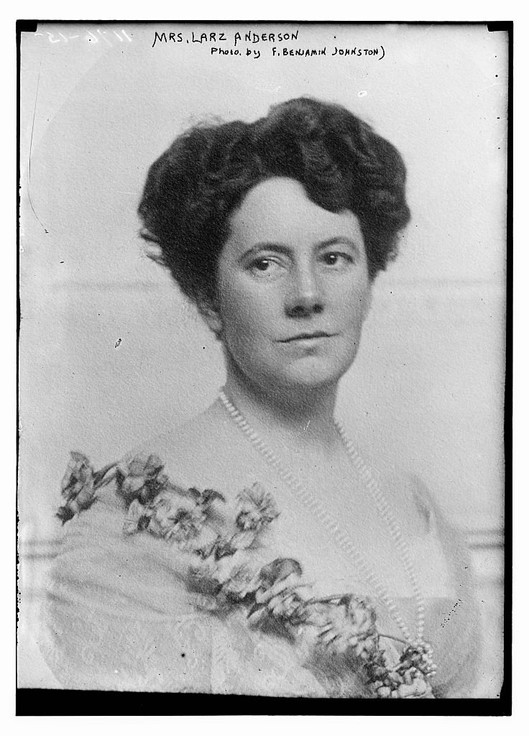
Belgian mission arriving at the Anderson House in 1917. Photo by Harris & Ewing, courtesy of the Library of Congress.
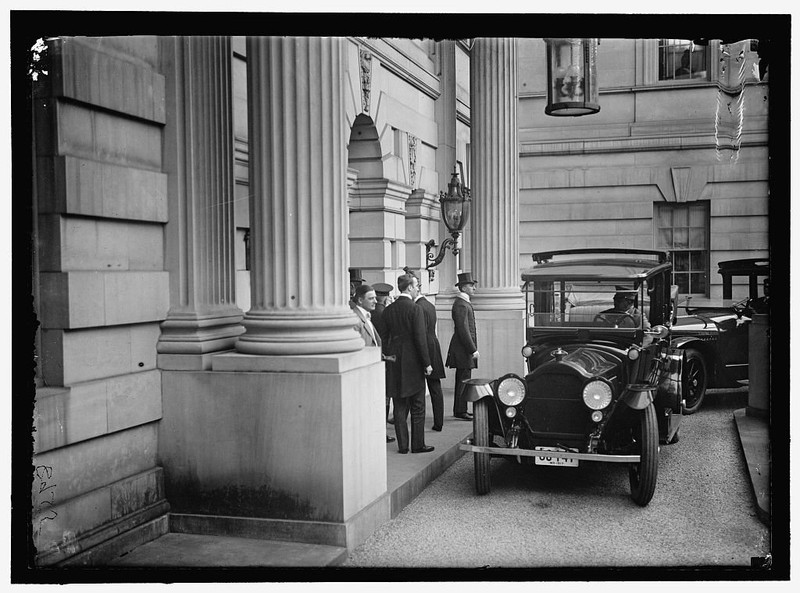
Dining room at the Anderson House. Wikimedia Commons.
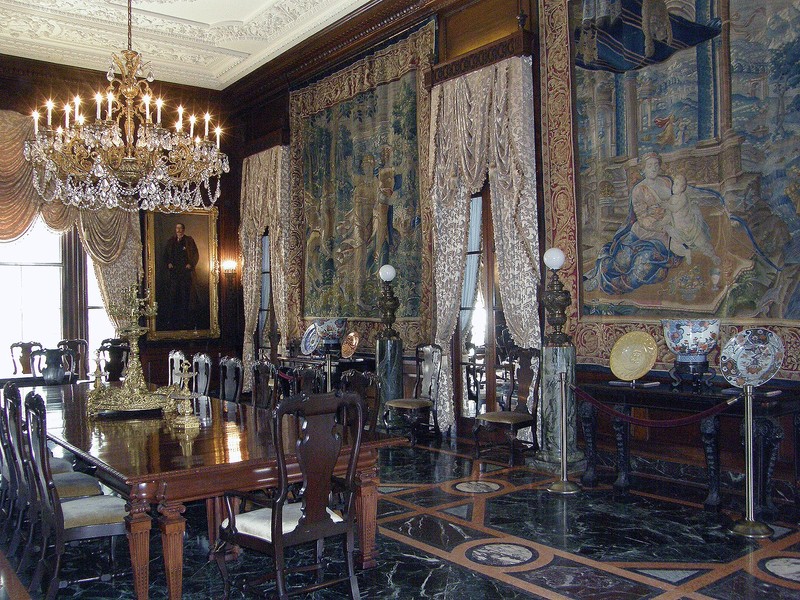
Backstory and Context
Text-to-speech Audio
The Anderson House is situated among the largest concentration of embassies in Washington, D.C. In the early twentieth century, this elegant Beaux Arts mansion was constructed as part of a larger, growing neighborhood of wealthy and politically active locals and dignitaries from around the world. It is suitable that the well-traveled and politically active Larz and Isabel Anderson, along with the Society of the Cincinnati, would call this place home.
Larz and Isabel Anderson were both descended from old American wealth and military officers, tracing their lineages to the colonies. Larz Anderson was born in 1866 to the high-class Anderson family of Cincinnati, Ohio. His family provided Anderson with extensive opportunities to better himself through education. After studying at Phillips Exeter Academy and Harvard College, he embarked on a grand tour of the world for a year and a half. Upon his return, Anderson briefly attended Harvard Law School until offered diplomat position in London, which his father and minister to Britain, Robert Todd Lincoln, encouraged him to pursue. In 1894, Anderson was sent to Rome for diplomatic work, where in 1896 he met his soon to be wife, Isabel Weld Perkins, who was traveling Europe for a year. At the time, she was considered the richest woman the United States, with an inheritance of $17 million. In 1897, Larz and Isabel were wed. As they were both inheritors of large fortunes, they toured the world together. They returned to the United States when Larz volunteered to serve in the Spanish-American War in 1898, following in the footsteps of his family’s military history dating back to the American Revolution.
In the early 1900s, the Andersons commissioned the architect firm Little and Browne of Boston to design their mansion in Washington, D.C. Construction on the home was completed in 1905 and the Andersons began entertaining guests in their sizable abode. The mansion, which cost $750,000, included fifty rooms with luxurious interior details such as wood detailing, gilded papier-mâché ceilings, iron staircases, marble floors, central heat, elevators, and telephones. The grounds included a tennis court a walled garden, and carriage house. The Andersons filled the mansion with paintings, murals, tapestries, sculptures, and furniture from around the world. They held numerous diplomatic gatherings in the home and were well-known in the area because of it. Maintaining the house, its priceless objects, and numerous events required the hard work of around twenty servants, who also lived in the house. Servants worked as chauffeurs, maids, butlers, cooks, housekeepers, and personal assistants to ensure the house remained in pristine condition for its residents and countless visitors. They lived in quarters on the third floor and outbuildings, did laundry and cared for the Andersons’ possessions on the fourth floor, and maintained heating systems in the basement.
The Andersons were active members of D.C. society and broader international networks. Larz Anderson continued his work as a diplomat, serving as minister to Belgium and ambassador to Japan. During World War I, Isabel Anderson led relief efforts in D.C.’s Red Cross and traveled to France and Belgium to care for the sick and wounded. Both Larz and Isabel were given prestigious awards for their work. Isabel Anderson also pursued a successful writing career, publishing nearly forty books including family histories, travelogues, children’s literature, and poetry.
In 1937, Larz Anderson died with no heirs, leaving the large estate to his widow. She donated the Anderson House to the Society of the Cincinnati, which Larz was a member of for forty years. The Society of the Cincinnati was established toward the end of the Revolutionary War in 1783, making it is the oldest patriotic organization in the United States. The name “Cincinnati” pays homage to a heroic figure of ancient Rome, Lucius Quinctius Cincinnatus, whose humility, sacrifice, and care for the public inspired the Society founders. Larz Anderson’s parents hailed from Cincinnati, Ohio, which was named in honor of the Society of the Cincinnati. In 1939, the Society opened the estate to the public as a museum, and the Anderson House has retained that public function to this day. On April 7th, 1971, the house was added to the National Register of Historic Places, and on June 19th, 1996, it was designated as a National Historic Landmark.
In 1937, Larz Anderson died with no heirs, leaving the large estate to his widow. She donated the Anderson House to the Society of the Cincinnati, which Larz was a member of for forty years. The Society of the Cincinnati was established toward the end of the Revolutionary War in 1783, making it is the oldest patriotic organization in the United States. The name “Cincinnati” pays homage to a heroic figure of ancient Rome, Lucius Quinctius Cincinnatus, whose humility, sacrifice, and care for the public inspired the Society founders. Larz Anderson’s parents hailed from Cincinnati, Ohio, which was named in honor of the Society of the Cincinnati. In 1939, the Society opened the estate to the public as a museum, and the Anderson House has retained that public function to this day. On April 7th, 1971, the house was added to the National Register of Historic Places, and on June 19th, 1996, it was designated as a National Historic Landmark.
The Andersons made numerous other estates and collections available to the public, including the Larz Anderson Auto Museum and Larz Anderson Park in Brookline, Massachusetts; the Perkins Manor in Contoocook, New Hampshire; and the Larz Anderson Bonsai Collection at Harvard University’s arboretum.
Sources
Anderson, Larz. Letters and Journals of a Diplomat. New York, 1940.
National Park Service. “Anderson House.” National Landmark Nomination Form. Washington, D.C.: National Park Service, Department of the Interior, 1996. Accessed December 2017. https://www.nps.gov/nhl/find/statelists/dc/Anderson.pdf
Society of the Cincinnati. “Name.” About. Society of the Cincinnati. Accessed December 2017. http://www.societyofthecincinnati.org/about/name
Society of the Cincinnati. “Behind the Scenes.” Anderson House. Society of the Cincinnati. Accessed December 2017. http://www.societyofthecincinnati.org/anderson_house/history/behind_the_scenes
Society of the Cincinnati. “History.” Anderson House. Society of the Cincinnati. Accessed December 2017. http://societyofthecincinnati.org/anderson_house/history
Society of the Cincinnati. “Larz and Isabel Anderson.” Anderson House. Society of the Cincinnati. Accessed December 2017. http://societyofthecincinnati.org/anderson_house/history/anderson
Images:
“The Larz Anderson House.” Photo. 2008. By AgnosticPreachersKid. Wikimedia Commons. Accessed December 2017. https://en.wikipedia.org/wiki/Larz_Anderson_House#/media/File:Larz_Anderson_House_-_Washington,_D.C..jpg
“Larz Anderson House, Washington, D.C. – ballroom.” Photo. 1890-1950. Francis Benjamin Johnston Collection. Library of Congress Prints and Photographs Division. Washington, D.C. Accessed December 2017. https://www.loc.gov/item/2001704537/
“Larz Anderson.” Photo. Date unknown. Bain News Service. George Grantham Bain Collection. Library of Congress Prints and Photographs Division. Washington, D.C. Accessed December 2017. https://www.loc.gov/item/ggb2004006043/
“Mrs. Larz Anderson.” Photo. Date unknown. F.B. Johnston. Library of Congress Prints and Photographs Division. Washington, D.C. Accessed December 2017. https://www.loc.gov/item/ggb2004006044/
“Belgian Mission to U.S.” Photo. 1917. Harris & Ewing Collection. Library of Congress Prints and Photographs Division. Washington, D.C. Accessed December 2017. https://www.loc.gov/item/hec2008006206/
"Dining Room." Photo. 2006. By Kathleen Cole. Wikimedia Commons. Accessed December 2017. https://commons.wikimedia.org/wiki/Category:Larz_Anderson_House#/media/File:ANDERSON-house_dining-ro...
